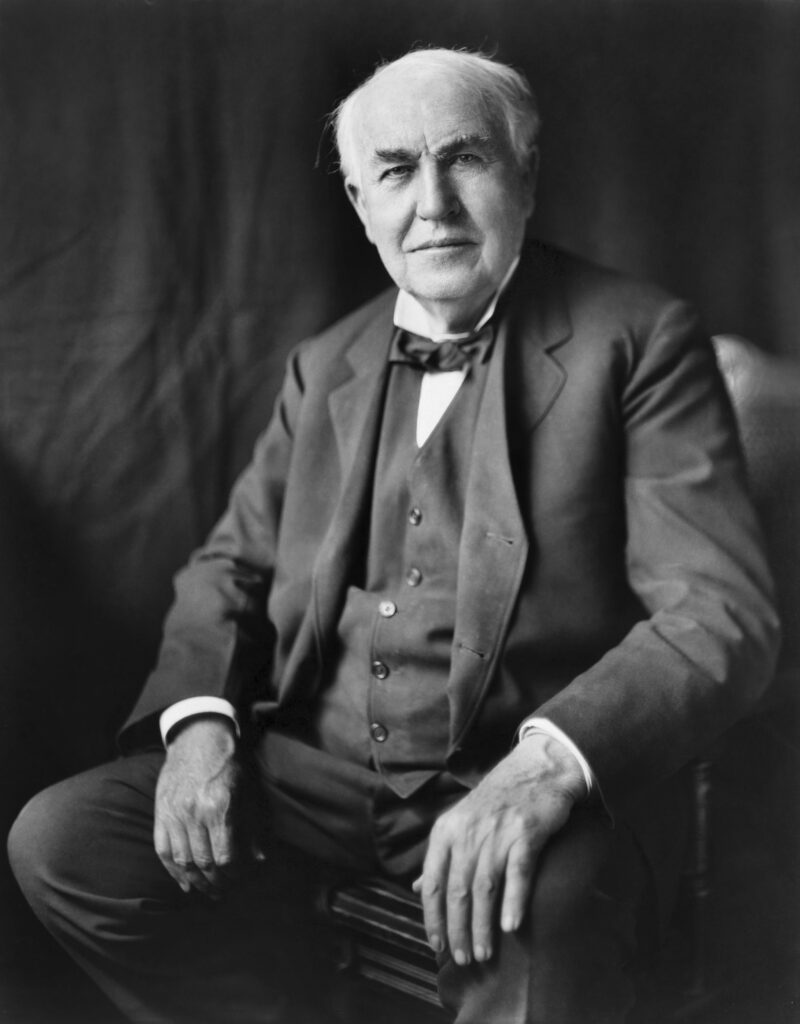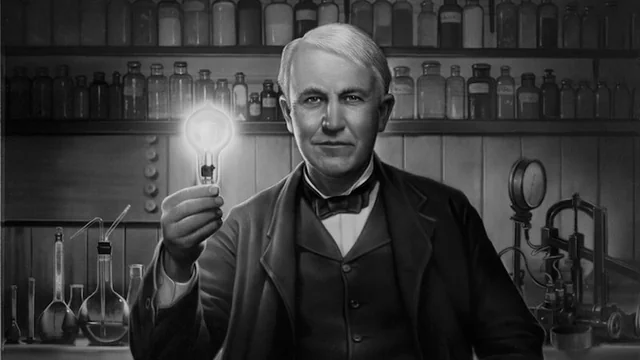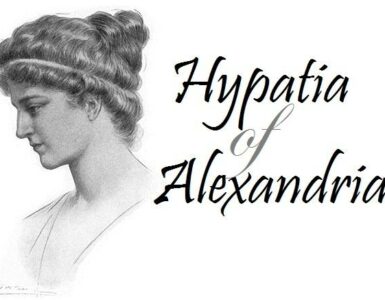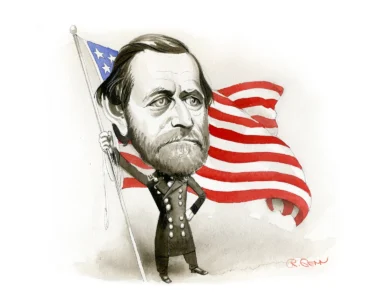Thomas Edison is one of the most famous inventors in history. His name is almost synonymous with innovation and invention. Born in 1847 in Milan, Ohio, Edison went on to become a prolific inventor who changed the world with his many groundbreaking creations. His inventions, particularly the electric light bulb, helped shape the modern world. Edison didn’t just create new technologies; he also revolutionized how these technologies were produced, used, and made accessible to the public. In this article, we’ll explore Edison’s life, his inventions, and his impact on society.

Early Life and Education
Thomas Edison was born on February 11, 1847, in Milan, Ohio, to Samuel Edison Jr. and Nancy Matthews Elliott. He was the youngest of seven children. Edison’s family moved to Port Huron, Michigan, when he was seven years old, and it was there that he grew up. As a child, Edison was not particularly a good student. His teachers thought he was slow to learn, and he was often described as being hyperactive. This led to him being sent to a special school by his mother, who believed in his abilities and wanted to nurture his curiosity.
Despite his early struggles in formal education, Edison was always very curious about the world around him. He loved experimenting and trying to understand how things worked. By the age of 10, Edison had already started conducting small experiments, and he would spend hours reading books on various subjects. His mother, who was a schoolteacher, supported his interest in science and learning.
The Early Career of Thomas Edison
Edison’s professional journey began at the age of 16 when he got his first job as a telegraph operator. He learned a lot about the telegraph system, which would later influence some of his inventions. During his early career, Edison worked on various projects and inventions. In fact, his first patent was granted in 1869 for an improved version of the telegraph, a device he invented at the age of 22.
In 1876, Edison moved to Menlo Park, New Jersey, where he set up a laboratory. It was here that he began working on his most famous inventions. Edison quickly gained a reputation for his work ethic, determination, and creativity. He became known as the “Wizard of Menlo Park” because of his innovative ideas and tireless work.
The Light Bulb and Electric Power
While Edison is perhaps best known for inventing the electric light bulb, the story is more complicated than simply “Edison invented the light bulb.” In fact, the light bulb had been around before Edison, but it was not practical for widespread use. The first electric lights were developed by inventors such as Humphry Davy and Warren de la Rue, but these early versions were either too dim or too dangerous.
Edison’s key contribution was developing a commercially viable version of the light bulb. In 1879, he succeeded in creating a bulb that could last for many hours and be produced on a large scale. Edison used a filament made of carbonized bamboo, which burned for a longer period than earlier designs. In addition to the bulb itself, Edison developed the electrical system that would make it practical to use light bulbs in homes and businesses.
Edison’s invention of the light bulb transformed the way people lived. Before the light bulb, people relied on candles, gas lamps, and oil lamps for light. These sources were either dangerous or inefficient. The electric light bulb revolutionized daily life, allowing people to work and live in a well-lit environment without the hazards associated with older lighting methods.

The Development of the Electric Power Industry
One of Edison’s most important contributions was not just inventing the light bulb but also creating a system that could distribute electricity. In 1882, Edison opened the first commercial power station in New York City. The Pearl Street Station, as it was called, generated electricity and distributed it to homes and businesses in the surrounding area.
The creation of the electric power industry marked the beginning of the widespread use of electricity. Edison’s system for generating and distributing electricity was the foundation for the modern electric grid that we use today. The electric power industry changed the way people lived, worked, and communicated, and it was a key factor in the industrial revolution.
The Battle with Nikola Tesla
While Edison was revolutionizing the electric power industry, he faced stiff competition from another brilliant inventor—Nikola Tesla. Tesla was a Serbian-American inventor who had a different approach to electricity. While Edison focused on direct current (DC), Tesla promoted alternating current (AC), which he believed was more efficient for long-distance transmission of electricity.
The rivalry between Edison and Tesla became known as the “War of Currents.” Edison, who had invested heavily in DC power, fought fiercely against AC, even going so far as to publicly criticize it. Tesla, on the other hand, believed that AC was superior and would eventually become the standard for electricity transmission.
Ultimately, Tesla’s ideas won out. In the 1890s, George Westinghouse, a businessman and inventor, helped bring AC power to the forefront, and it became the dominant system used for electricity transmission. While Edison’s direct current (DC) system was used for some time, AC power eventually became the industry standard, and it remains the method used today.
Edison’s Other Inventions
While the light bulb and the electric power system were Edison’s most famous inventions, he was responsible for many other groundbreaking innovations. Over his lifetime, Edison was granted more than 1,000 patents, making him one of the most prolific inventors in history. Some of his other inventions include:
- The Phonograph: In 1877, Edison invented the phonograph, the first machine capable of recording and playing back sound. This invention had a profound impact on the music industry and is considered one of Edison’s greatest achievements.
- The Motion Picture Camera: Edison also developed a motion picture camera and helped create the early film industry. His work in this area laid the foundation for modern cinema.
- The Electric Fan: Edison invented a small electric fan in the late 19th century that was used to cool people in warm climates.
Edison’s ability to come up with ideas and turn them into functional products was unmatched. His work in a variety of fields, from sound recording to motion pictures, demonstrated his broad range of interests and skills.
The Legacy of Thomas Edison
Thomas Edison passed away on October 18, 1931, at the age of 84. His death marked the end of an era, but his impact on the world is still felt today. Edison’s inventions changed the way people lived and worked, and his work paved the way for future technological advancements. His legacy continues to inspire inventors and innovators to this day.
Edison was a true pioneer who believed in the power of hard work and perseverance. He famously said, “Genius is 1% inspiration and 99% perspiration.” Edison’s life and career demonstrate that success is not just about having great ideas but also about working tirelessly to bring those ideas to life.
Conclusion
Thomas Edison’s life and work are a testament to the power of innovation and perseverance. His inventions, from the light bulb to the phonograph, have had a lasting impact on society and continue to shape our world today. Edison’s story is an inspiration to all those who strive to make a difference through creativity and determination. He will forever be remembered as one of the most important inventors in history.
Edison’s influence can still be seen in modern technology, from the way we light our homes to the way we listen to music and watch movies. His legacy is a reminder that even the most revolutionary ideas often start with a single spark of curiosity and a willingness to work hard to make those ideas a reality. Thomas Edison’s name will always be synonymous with innovation and the spirit of invention.





Add comment